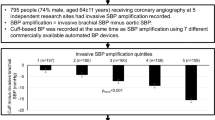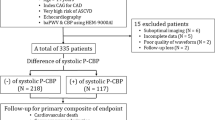Abstract
Brachial-to-radial-systolic blood pressure amplification (Bra-Rad-SBPAmp) can affect central SBP estimated by radial tonometry. Patients with type 2 diabetes mellitus (T2DM) have vascular irregularities that may alter Bra-Rad-SBPAmp. By comparing T2DM with non-diabetic controls, we aimed to determine the (1) magnitude of Bra-Rad-SBPAmp; (2) haemodynamic factors related to Bra-Rad-SBPAmp; and (3) effect of Bra-Rad-SBPAmp on estimated central SBP. Twenty T2DM (64±8 years) and 20 non-diabetic controls (60±8 years; 50% male both) underwent simultaneous cuff deflation and two-dimensional ultrasound imaging of the brachial and radial arteries. The first Korotkoff sound (denoting SBP) was identified from the first inflection point of Doppler flow during cuff deflation. Bra-Rad-SBPAmp was calculated by radial minus brachial SBP. Upper limb and systemic haemodynamics were recorded by tonometry and ultrasound. Radial SBP was higher than brachial SBP for T2DM (136±19 vs 127±17 mm Hg; P<0.001) and non-diabetic controls (135±12 vs 121±11 mm Hg; P<0.001), but Bra-Rad-SBPAmp was significantly lower in T2DM (9±8 vs 14±7 mm Hg; P=0.042). The product of brachial mean flow velocity × brachial diameter was inversely and independently correlated with Bra-Rad-SBPAmp in T2DM (β=−0.033 95% confidence interval −0.063 to −0.004, P=0.030). When radial waveforms were calibrated using radial, compared with brachial SBP, central SBP was significantly higher in both groups (T2DM, 116±13 vs 125±15 mm Hg; and controls, 112±10 vs 124±11 mm Hg; P<0.001 both) and there was a significant increase in the number of participants classified with ‘central hypertension’ (SBP⩾130 mm Hg; P=0.004). Compared with non-diabetic controls, Bra-Rad-SBPAmp is significantly lower in T2DM. Regardless of disease status, radial SBP is higher than brachial SBP and this results in underestimation of central SBP using brachial-BP-calibrated radial tonometry.
This is a preview of subscription content, access via your institution
Access options
Subscribe to this journal
Receive 12 digital issues and online access to articles
$119.00 per year
only $9.92 per issue
Buy this article
- Purchase on Springer Link
- Instant access to full article PDF
Prices may be subject to local taxes which are calculated during checkout


Similar content being viewed by others
References
Vlachopoulos C, Aznaouridis K, O’Rourke MF, Safar ME, Baou K, Stefanadis C . Prediction of cardiovascular events and all-cause mortality with central haemodynamics: a systematic review and meta-analysis. Eur Heart J 2010; 31 (15): 1865–1871.
Williams B, Lacy PS, Thom SM, Cruickshank K, Stanton A, Collier D et al. Differential impact of blood pressure-lowering drugs on central aortic pressure and clinical outcomes: principal results of the Conduit Artery Function Evaluation (CAFE) study. Circulation 2006; 113 (9): 1213–1225.
Huang CM, Wang KL, Cheng HM, Chuang SY, Sung SH, Yu WC et al. Central versus ambulatory blood pressure in the prediction of all-cause and cardiovascular mortalities. J Hypertens 2011; 29 (3): 454–459.
Sharman JE . Central pressure should be used in clinical practice. Artery Res 2015; 9: 1–7.
Sharman JE, Marwick TH, Gilroy D, Otahal P, Abhayaratna WP, Stowasser M . Randomized trial of guiding hypertension management using central aortic blood pressure compared with best-practice care: principal findings of the BP GUIDE Study. Hypertension 2013; 62 (6): 1138–1145.
Sharman JE, Laurent S . Central blood pressure in the management of hypertension: soon reaching the goal? J Hum Hypertens 2013; 27 (7): 405–411.
Laurent S, Cockcroft J, Van Bortel L, Boutouyrie P, Giannattasio C, Hayoz D et al. Expert consensus document on arterial stiffness: methodological issues and clinical applications. Eur Heart J 2006; 27 (21): 2588–2605.
Sharman JE, Lim R, Qasem AM, Coombes JS, Burgess MI, Franco J et al. Validation of a generalized transfer function to noninvasively derive central blood pressure during exercise. Hypertension 2006; 47 (6): 1203–1208.
O’Rourke MF, Takazawa K . Flawed measurement of brachial tonometry for calculating aortic pressure? Hypertension 2009; 54 (5): e131 author reply e2.
Picone DS, Climie RE, Ahuja KD, Keske MA, Sharman JE . Brachial-to-radial SBP amplification: implications of age and estimated central blood pressure from radial tonometry. J Hypertens 2015; 33: 1876–1883.
Davies JE, Shanmuganathan M, Francis DP, Mayet J, Hackett DR, Hughes AD . Caution using brachial systolic pressure to calibrate radial tonometric pressure waveforms: lessons from invasive study. Hypertension 2010; 55 (1): e4.
Kroeker EJ, Wood EH . Beat-to-beat alterations in relationship of simultaneously recorded central and peripheral arterial pressure pulses during Valsalva maneuver and prolonged expiration in man. J Appl Physiol 1956; 8 (5): 483–494.
Kroeker EJ, Wood EH . Comparison of simultaneously recorded central and peripheral arterial pressure pulses during rest, exercise and tilted position in man. Circ Res 1955; 3 (6): 623–632.
Segers P, Mahieu D, Kips J, Rietzschel E, De Buyzere M, De Bacquer D et al. Amplification of the pressure pulse in the upper limb in healthy, middle-aged men and women. Hypertension 2009; 54 (2): 414–420.
Verbeke F, Segers P, Heireman S, Vanholder R, Verdonck P, Van Bortel LM . Noninvasive assessment of local pulse pressure: importance of brachial-to-radial pressure amplification. Hypertension 2005; 46 (1): 244–248.
Cheng HM, Lang D, Tufanaru C, Pearson A . Measurement accuracy of non-invasively obtained central blood pressure by applanation tonometry: a systematic review and meta-analysis. Int J Cardiol 2013; 167 (5): 1867–1876.
Cheng HM, Chuang SY, Sung SH, Yu WC, Pearson A, Lakatta EG et al. Derivation and validation of diagnostic thresholds for central blood pressure measurements based on long-term cardiovascular risks. J Am Coll Cardiol 2013; 62 (19): 1780–1787.
Climie RED, Nikolic SB, Otahal P, Keith LJ, Sharman JE . Augmentation index and arterial stiffness in patients with type 2 diabetes mellitus. Artery Res 2013; 7 (3–4): 194–200.
Schram MT, Henry RM, van Dijk RA, Kostense PJ, Dekker JM, Nijpels G et al. Increased central artery stiffness in impaired glucose metabolism and type 2 diabetes: the Hoorn Study. Hypertension 2004; 43 (2): 176–181.
Megnien JL, Simon A, Valensi P, Flaud P, Merli I, Levenson J . Comparative effects of diabetes mellitus and hypertension on physical properties of human large arteries. J Am Coll Cardiol 1992; 20 (7): 1562–1568.
Schultz MG, Climie RE, Nikolic SB, Ahuja KD, Sharman JE . Persistent elevation of central pulse pressure during postural stress in patients with type 2 diabetes mellitus. J Hum Hypertens 2013; 27 (7): 437–444.
Rizzoni D, Porteri E, Guelfi D, Muiesan ML, Valentini U, Cimino A et al. Structural alterations in subcutaneous small arteries of normotensive and hypertensive patients with non-insulin-dependent diabetes mellitus. Circulation 2001; 103 (9): 1238–1244.
de Jager J, Dekker JM, Kooy A, Kostense PJ, Nijpels G, Heine RJ et al. Endothelial dysfunction and low-grade inflammation explain much of the excess cardiovascular mortality in individuals with type 2 diabetes: the Hoorn Study. Arterioscler Thromb Vasc Biol 2006; 26 (5): 1086–1093.
Palatini P, Frigo G, Bertolo O, Roman E, Da Corta R, Winnicki M . Validation of the A&D TM-2430 device for ambulatory blood pressure monitoring and evaluation of performance according to subjects’ characteristics. Blood Press Monit 1998; 3 (4): 255–260.
Aboyans V, Criqui MH, Abraham P, Allison MA, Creager MA, Diehm C et al. Measurement and interpretation of the ankle-brachial index: a scientific statement from the American Heart Association. Circulation 2012; 126 (24): 2890–2909.
Stergiou GS, Giovas PP, Gkinos CP, Tzamouranis DG . Validation of the A&D UM-101 professional hybrid device for office blood pressure measurement according to the International Protocol. Blood Press Monit 2008; 13 (1): 37–42.
Pauca AL, Wallenhaupt SL, Kon ND, Tucker WY . Does radial artery pressure accurately reflect aortic pressure? Chest 1992; 102 (4): 1193–1198.
Huynh Q, Blizzard L, Sharman J, Magnussen C, Schmidt M, Dwyer T et al. Relative contributions of adiposity in childhood and adulthood to vascular health of young adults. Atherosclerosis 2013; 228 (1): 259–264.
Charloux A, Lonsdorfer-Wolf E, Richard R, Lampert E, Oswald-Mammosser M, Mettauer B et al. A new impedance cardiograph device for the non-invasive evaluation of cardiac output at rest and during exercise: comparison with the "direct" Fick method. Eur J Appl Physiol 2000; 82 (4): 313–320.
Schultz MG, Climie RE, Nikolic SB, Ahuja KD, Sharman JE . Reproducibility of cardiac output derived by impedance cardiography during postural changes and exercise. Artery Res 2012; 6 (2): 78–84.
Xu JS, Wu YQ, Su H, Hu WT, Li JX, Wang WY et al. The value of a BP determination method using a novel non-invasive bp device against the invasive catheter measurement. PLoS ONE 2014; 9 (6): e100287.
Nichols WW, O’Rourke MF . McDonald's Blood Flow in Arteries: Theoretical Experimental and Clinical Principles. 5th edn Hodder Arnold: London, UK, 2005.
Pauca AL, O’Rourke MF, Kon ND . Prospective evaluation of a method for estimating ascending aortic pressure from the radial artery pressure waveform. Hypertension 2001; 38 (4): 932–937.
Mangoni AA, Giannattasio C, Brunani A, Failla M, Colombo M, Bolla G et al. Radial artery compliance in young, obese, normotensive subjects. Hypertension 1995; 26 (6 Pt 1): 984–988.
Soender TK, Van Bortel LM, Moller JE, Lambrechtsen J, Hangaard J, Egstrup K . Impact of calibration on estimates of central blood pressures. J Hum Hypertens 2012; 26 (12): 706–710.
Weber T, Wassertheurer S, Rammer M, Maurer E, Hametner B, Mayer CC et al. Validation of a brachial cuff-based method for estimating central systolic blood pressure. Hypertension 2011; 58 (5): 825–832.
Cheng HM, Sung SH, Chuang SY, Pearson A, Tufanaru C, White S et al. Diagnostic performance of a stand-alone central blood pressure monitor: application of central blood pressure in the diagnosis of high blood pressure. Am J Hypertens 2014; 27 (3): 382–391.
Charmoy A, Wurzner G, Ruffieux C, Hasler C, Cachat F, Waeber B et al. Reactive rise in blood pressure upon cuff inflation: cuff inflation at the arm causes a greater rise in pressure than at the wrist in hypertensive patients. Blood Press Monit 2007; 12 (5): 275–280.
Acknowledgements
JES is supported by a National Health and Medical Research Council Career Development Award (reference 569519).
Author information
Authors and Affiliations
Corresponding author
Ethics declarations
Competing interests
The authors declare no conflict of interest.
Rights and permissions
About this article
Cite this article
Climie, R., Picone, D., Keske, M. et al. Brachial-to-radial systolic blood pressure amplification in patients with type 2 diabetes mellitus. J Hum Hypertens 30, 404–409 (2016). https://doi.org/10.1038/jhh.2015.101
Received:
Revised:
Accepted:
Published:
Issue Date:
DOI: https://doi.org/10.1038/jhh.2015.101
This article is cited by
-
Central-to-brachial blood pressure amplification in type 2 diabetes: a systematic review and meta-analysis
Journal of Human Hypertension (2019)



